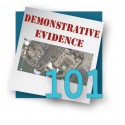Menu

Morgan Smith
Litigation Tip: The Best Way to Get Demonstrative Evidence Admitted at Trial
 The other day an attorney from the state of Illinois contacted me out of the blue because he had seen my blog and wanted advice on preparing presentations for his jury trial. He asked, “Do you have problems with the other side objecting to your presentations? If so, what’s the basis of those objections, and how do you overcome them?”
The other day an attorney from the state of Illinois contacted me out of the blue because he had seen my blog and wanted advice on preparing presentations for his jury trial. He asked, “Do you have problems with the other side objecting to your presentations? If so, what’s the basis of those objections, and how do you overcome them?”
I was glad to hear his questions, and I always want to support attorneys using demonstrative evidence and trying new things in terms of design and tech. This post provides a primer on demonstrative evidence and shares advice on how to overcome objections to getting important demonstratives into evidence.
I told him that the vast majority of what we make for clients is demonstrative in nature and not admissible evidence itself. That means we generally only have to show that it’s substantially similar to what existed and will likely help the jury understand the case, and not be too prejudicial.
What is Demonstrative Evidence?
Demonstrative evidence is pretty much any evidence other than testimony that is presented during the course of a civil or criminal trial. Demonstrative evidence includes actual evidence (e.g., a set of bloody gloves from a murder scene) and illustrative evidence (e.g., photographs and charts showing the scene). Both types of demonstrative evidence are admissible depending on the foundation you lay.
Is Demonstrative Evidence Admissible?
It is well settled that demonstrative evidence is admissible for the purpose of illustrating and clarifying a witness’s testimony. (People v. Kynette, 15 Cal.2d 731, 755; St. George v. Superior Court, 93 Cal.App.2d 815, 816; see Witkin, Cal. Evidence (2d ed. 1966) § 642, p. 604.) Because demonstrative evidence is used to illustrate testimony, it is generally authenticated by the witness whose testimony is being illustrated. That witness will usually identify salient features of the exhibit and testify that it fairly and accurately reflects what he or she saw or heard on a particular occasion, such as the location of people or things on a diagram.
When our firm makes an accident reconstruction video, for example, the foundation for the video is through the accident reconstruction expert who will testify that such video shows his opinion and will help the jury understand it. Any medical animation or diagram will use the doctor as the foundation.
California law does not require demonstrative evidence to be exact, but only substantially similar and helpful to the jury. (See Andrews v. Barker Brothers Corp., 267 Cal. App.2d 530, 537.)
In Culpepper v. Volkswagen of America, Inc. (1973) 33 Cal. App.3d 510, 521 the court examined the admissibility of an expert’s reconstruction. The court found the evidence must meet the following requirements:
(1) The [re-creation] must be relevant (Evid. Code, §§ 210, 351); (2) the [recreation] must have been conducted under substantially similar conditions as those of the actual occurrence [citation]; and (3) the evidence of the [recreation] will not consume undue time, confuse the issues or mislead the jury [citation].
The most likely objection for demonstrative evidence comes from Evidence Code Sec. 352 (Fed. Rule Evid. 403) for being more prejudicial than probative. The judge has discretion to allow or not allow this exhibit into evidence, and that judge’s decision will only be overturned on appeal for an abuse of discretion.
How are you most likely overcome the judge’s discretion and get demonstrative evidence admitted (or at least shown to the jury) at trial?
The best way to get any important demonstratives into evidence is to produce them as early to the other side as possible. If you plan on having an exhibit that an expert uses to explain their testimony and theories, make sure to have it finished and provided with the expert for their deposition. This gives the other side the due process right to ask about the exhibit, any assumptions made and other questions. Providing to the other side right before the expert is going to testify potentially raises a fairness issue for the opposing counsel that can be avoided.
If you plan to do an electronic opening statement (such as with PowerPoint and/or Keynote), make sure to provide all slides that have exhibits, diagrams or pictures to the other side long before the opening. When I was trying cases frequently, it was usually my practice to file a motion in limine that asked for a ruling that all the attached diagrams, exhibits and evidence be allowed for use in Opening; then, I would attach all the opening statement slides to the motion.
I have been told by some attorneys that they have never been allowed to show evidence in an opening statement absent agreement and stipulation of opposing counsel (which is rarely given). However, my experience was that if you provide demonstratives to the court early, for a timely determination of any real objection to the evidence at trial, then the perfunctory objections of opposing counsel were simply overruled.
For more advice on using computer animations as demonstrative evidence, along with a downloadable legal brief on the subject, please see my earlier post, Why Attorneys Need to Know Computer “Animations” vs. “Simulations” for Trial.
If you’d like to receive updates from this blog, please click to subscribe by email.
Recent Posts
- Proper Digital Discovery, Part IV: Using Drones in Modern Litigation
- Proper Digital Discovery, Part III: Using Digital Imagery in Modern Litigation
- Proper Digital Discovery, Part II: Electronic Measuring Data
- How to Obtain Proper Digital Discovery, Part I: Photography
- California Courts – Latest Updates
